So What's a Tessellator?
This has been covered before now in other articles about DirectX 11, but we first touched on the subject with the R600 launch. Both R6xx and R7xx hardware have tessellators, but since these are proprietary implementations, they won't be directly compatible with DirectX 11 which uses a much more sophisticated setup. While neither AMD nor the DX11 tessellator itself are programmable, DX11 includes programmable input to and output from the tesselator (TS) through two additional pipeline stages called the Hull Shader (HS) and the Domain Shader (DS).
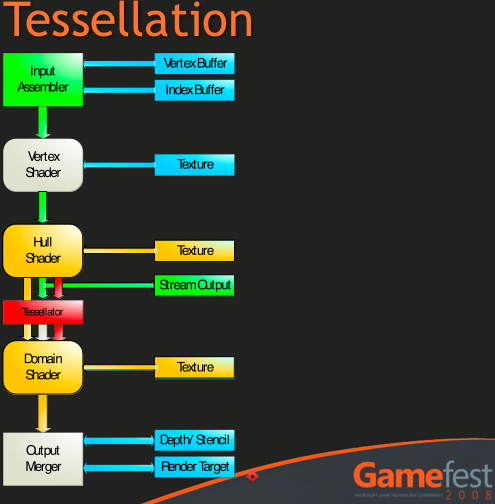
The tessellator can take coarse shapes and break them up into smaller parts. It can also take these smaller parts and reshape them to form geometry that is much more complex and that more closely approximates reality. It can take a cube and turn it into a sphere with very little overhead and much fewer space requirements. Quality, performance and manageability benefit.
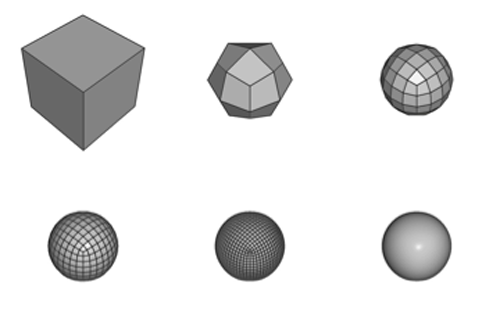
The Hull Shader takes in patches and control points out outputs data on how to configure the tessellator. Patches are a new primitive (like vertices and pixels) that define a segment of a plane to be tessellated. Control points are used to define the parametric shape of the desired surface (like a curve or something). If you've ever used the pen tool in Photoshop, then you know what control points are: these just apply to surfaces (patches) instead of lines. The Hull Shader uses the control points to determine how to set up the tessellator and then passes them forward to the Domain Shader.
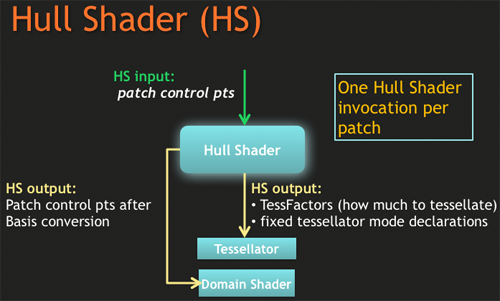
The tessellator just tessellates: it breaks up patches fed to it by the Hull Shader based on the parameters set by the Hull shader per patch. It outputs a stream of points to the Domain Shader, which then needs to finish up the process. While programmers must write HS programs for their code, there isn't any programming required for the TS. It's just a fixed function block that processes input based on parameters.
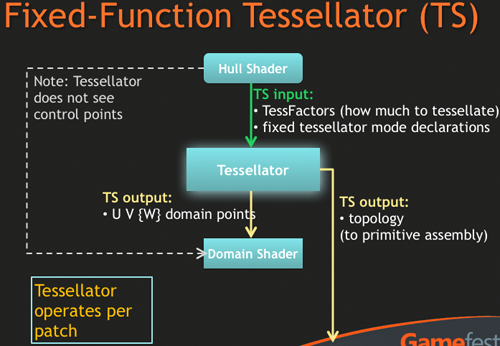
The Domain Shader takes points generated by the tessellator and manipulates them to form the appropriate geometry based on control points and/or displacement maps. It performs this manipulation by running developer designed DS programs which can manipulate how the newly generated points are further shifted or displaced based on control points and textures. The Domain Shader, after processing a point, outputs a vertex. These vertices can be further processed by a Geometry Shader, which can also feed them back up to the Vertex Shader using stream out functionality. More likely than heading back up for a second pass, we will probably see most output of the Domain Shader head straight on to rasterization so that its geometry can be broken down into screen space fragments for Pixel Shader processing.
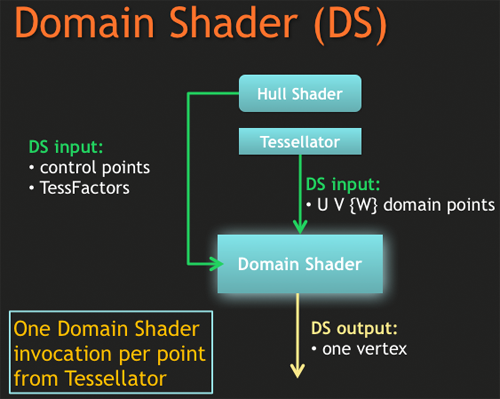
That covers what the basics of what the tesselator can do and how it does it. But do you find your self wondering: "self, can't the Geometry Shader just be used to create tessellated surfaces and move the resulting vertices around?" Well, you would be right. That is technically possible, but not practical at this point. Let's dive into that a bit more.










109 Comments
View All Comments
just4U - Wednesday, February 4, 2009 - link
While there might be some programs out there that definitely do take advantage of 8G of ram.. I haven't noticed that for Vista. It seems to hit a sweet spot at 4Gigs (or 3.3 for 32bit) I don't think 2Gigs of ram is optimal for Vista at all tho, and always push for 4 with all my builds.dzmcm - Tuesday, February 3, 2009 - link
Do yourself the biggest favor and Google kat mouse. I used ubuntu for a while and got spoiled by the mouse wheel functionality. This little program will allow your to scroll windows not in focus. And it adds extra functionality to the middle mouse button (which I just dissable). Plus you can set up per application rules.SoCalBoomer - Monday, February 2, 2009 - link
Fail. Sigh.A: 2Gigs works great. 3 Works FINE. 4 works happily with 64.
B: DECENT video cards work fine. By Decent, I mean anything in the past couple of years - nVidia 7xxx cards, for instance. PCI vid cards? Prolly not. . .
C: Why not just do it within Windows? UAC is easy to turn off. Windows Defender actually works okay. Readyboost doesn't do anything if you don't turn it on, etc.
"Nothing like Ubuntu though" - true. I have Ubuntu on my laptop (although it's got Win7 on it and is a TON more functional now) but then Ubuntu doesn't have ANY common use programs written for it - Open Office is about it and . . . much as I like it, it's missing stuff that I use every day on my desktop.
Games? Well, yes, but there are things other than games - like Office. . . yeah, you know, that behemoth office suite that controls the world? Yeah, not necessarily my fav (except for OneNote - which is awesome) but you gotta do it.
You can't make your mouse work the way you want and THEREFORE Vista fails? Dude. . . epic fail.
stmok - Saturday, January 31, 2009 - link
Vista IS a marketing failure.* It failed to get massive adoption as expected by Microsoft. A good majority of people and businesses are sticking with XP. Go and actually search for world wide statistics, and you'll see for yourself.
* No matter how much Microsoft spent on marketing (see Seinfield+Gates ads and Mojave), it never caught on...Viral and deceptive marketing don't work.
* Why do you think the next one is called "Windows 7" (even though you can basically call it Windows Vista Second Edition). Simple. The name "Vista" is a marketing failure. Its kryptonite to the Windows brand name. That's why they dropped it.
Linux works well when the user has strong motivations to learn and adopt it. When they don't, they are better off using something like Linux Mint (which has all the video codec, and Flash, etc pre-installed) or not even using Linux at all. (Which is better for all involved).
When a user treats Linux like Windows, it just doesn't work. Hence, all the complaining about how Linux on the desktop won't happen. (Linux was never intended for the desktop. The point was to create a cheap Unix-like solution for the x86 platform).
Many don't realise that in Linux, the people take responsibility, not a company like Apple or Microsoft. Its about getting your butt off the ground and doing things to make it happen.
Nothing happens when all you do is sit and complain how Linux isn't this all or that. Its up to you (if you choose to), to do something about it...This is identical to life itself.
gochichi - Thursday, February 19, 2009 - link
If Microsoft wants to go Windows 7 early, they need to reconsider their pricing for Vista upgraders. B/c I have 3 Vista computers and I'm unwilling to spend more than $100.00 to upgrade all 3 of them to Windows 7.That's $33.33 per computer as my ceiling. And I'm not going to upgrade one and not all of them. I have more than earned the right to a good price from Microsoft. If they want to charge me full price for Office 2010 (or whatever it'll be called) that's fine, but OS upgrades can't be $100+ a pop, not if Microsoft wants to change OS's every two years.
I kind of wonder if Vista will pick up traction in the piracy circles once 7 is released. I don't even know if I'll want to upgrade period... I mean, Vista really is fine, and why fix what aint broke.
I've tried Windows 7 and other than being unusually unstable (which is "alright" technically because it's a beta) it does offer up some decent usability improvements. I'm quite sure that most Vista users will feel like I do... namely, that we should be getting the cosmetic upgrades for free... since we're footing their bills and all. Windows 7 is just warmed over Vista... and frankly if you're excited about Windows 7 yet you "hate" Vista... you're weird b/c they're the same thing.
Like I said, Windows 7 is UNSTABLE which given the "mission statement" is truly alarming. I mean, I'm running Windows 7 by itself (no apps installed) and yet sometimes Windows Explorer needs to restart (one of my biggest gripes (probably the only legitimate one) with Vista).
I guess those of us even considering buying OSes separately from PCs are crazy, and now with Windows 7 we'll be even crazier (pricing pending). Hopefully Microsoft will offer us a hand so we can all leave Vista (not because it's horrible, just for uniformity) together. Otherwise, Windows 7 will probably have even worse adoption rates than Vista.
Microsoft: Don't be greedy! Don't split your user base so much. Let me have computers with the same OS without charging me an arm and a leg. Let Vista users have access to DirectX 11 too... b/c the "gaming" community is just going to backlash and boycott 7 like they did Vista.
We all "naturally" want the latest version of the OS, coercion isn't necessary at all.
x86 64 - Thursday, February 26, 2009 - link
Nah, Vista is already easier to pirate than XP ever was. All you need is a BIOS with an SLIC table and a VLK (easily done yourself with some research). Then you activate it using Vista's Software License Service (SLsvc.exe the way big OEM's like Dell and HP mass activate PC's) and MS can't tell the difference between a bogus or a legit installation, unless they overhaul their validation methods (not likely).With XP you had to deal with trying to remove the WGA nagware. Also there are some WinXP Pro student editions floating around that don't need activation because they don't contain WGA. The thought was that eventually MS would ban these keys but it has yet to happen.
I imagine Windows 7 will be just as easy as to pirate as Vista, either through a BIOS softmod or foolproof BIOS hardmod.
nilepez - Wednesday, February 4, 2009 - link
WTF are you talking about? Why would MS have expected Vista to get 30 or 40% market share after 2 years?For all the BS that XP is God and sold like gangbusters out the door, a little research shows that XP had less than 40% market share in 2005
You'd have to be a complete idiot to think that Businesses were transition to Vista quicker than they transitioned to XP.
swaaye - Monday, February 2, 2009 - link
I think Vista has "failed" only because there's little reason for the vast majority of users to switch to it. It's very expensive to upgrade to it, and there's just little reason to. The fact of the matter is that for everyone that doesn't care about DX10 gaming, XP can do anything Vista can.Personally, I think Vista is ok. If Win 7 improves on it, there's nowhere to go but up. But I also have no dislike of XP, either, and certainly see that it has its place on every PC with <2GB RAM.
michaelklachko - Monday, February 2, 2009 - link
That's a good post. Especially about Linux. Thanks!